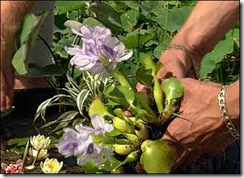The water hyacinth is one of the world’s most invasive freshwater plants. Native to the Amazon region, it was introduced as an ornamental plant worldwide. Its beautiful leaves and flowers are appealing, but its aggressive growing habits have had a negative ecological and economic impact in tropical and subtropical regions around the world.
Appearance
-
The water hyacinth is a free-floating aquatic herb, with thick, glossy leaves that rise above the surface on underwater stems. Its six-petaled flowers range in color from purple to light blue to white. The flower clusters grow on a spike or stem that can hold from 10 to 35 blooms.
Growth Habits
-
Unlike some aquatic plants, the water hyacinth does not usually take root. It forms a free-floating, dense mat that, according to the Center for Aquatic and Invasive Plants, can weigh up to 200 tons and contain thousands of individual plants. The plant is fast-growing, sometimes doubling its population in less than a week. Seeds from the plant can remain viable for 20 years. In tropical and subtropical regions it is a perennial; in temperate climates it survives only as an annual.
Environmental Impact
-
The water hyacinth is highly invasive. Its dense pattern of growth clogs slow-moving and still water, including ponds, canals, lakes and ditches. The heavy mats greatly reduce water flow in canals and drainage ditches, causing flooding, and the thick foliage can block intake pumps in irrigation canals and threaten the working of hydro-electric systems. Competing with native flora and fauna for nutrients, the huge mats also raise water temperatures, reduce oxygen levels and block sunlight necessary for the survival of other aquatic species. The water hyacinth is considered a serious threat to biodiversity in most areas where it has been introduced.
Distribution
-
The water hyacinth is found in approximately 50 countries. Its distribution has been mainly by human agents, introduced into non-native areas as an ornamental plant. In North America, it is found in Florida, Louisiana and other southeastern states, as well as in California and Hawaii. Though also found in other U.S. states, it cannot tolerate winter temperatures and has not become established. It flourishes in Mexico and most countries in Central America.
In parts of Africa the plant has clogged waterways, including sections of the Nile and Congo Rivers. Most of Europe has escaped the worst of the infestation because of its temperate climate, although Spain is reported to have problems. South and Southeast Asia’s farming and fishing industries have been negatively impacted by the proliferation of the plant.
Australia, New Zealand and many islands in the Pacific have serious problems with the water hyacinth’s rapid growth, although New Zealand began an early campaign to control and eradicate the plant. Native to the Amazon region of Brazil, the plant has spread to other areas of South America, from Colombia to Argentina.
Control
-
Manual removal of small mats of water hyacinths by hand or mechanical harvester has worked, but for large-scale infestations this method of control is not feasible. Herbicides have also been effective, but application must sometimes be repeated and can be toxic to other flora and fauna. The use of biological agents has shown positive results in some areas, such as Africa’s Lake Victoria where the introduction of water-hyacinth weevils resulted in the eradication of the plant. Prevention is one of the best methods of control, and public-awareness campaigns and laws prohibiting the sale of water hyacinths have been effective.


Deprecated: strpos(): Passing null to parameter #1 ($haystack) of type string is deprecated in /home/agriviek8Qv/agriviet.net/public_html/wp-includes/comment-template.php on line 2522